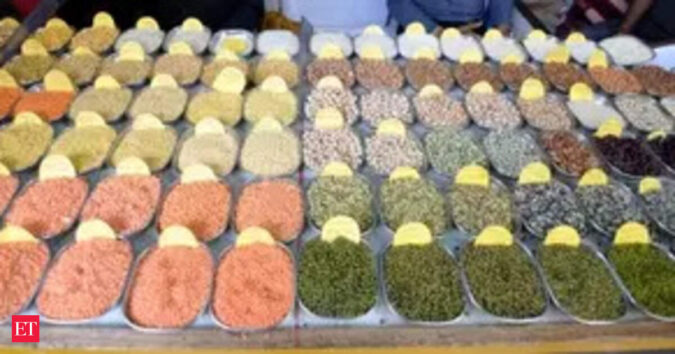India saw double-digit inflation in pulses for much of 2023 and 2024 after the government did not receive early warning to either boost procurement or adjust import duties, they said, citing an analysis of official data. The ministry is expected to release first estimates for kharif 2025 and its fourth estimate for crop year 2024-25 soon.
In the past two years, as domestic production of pulses fell short owing to the vagaries of weather, an increase in imports took time as the signal to lower duties reached the government late. Pulses imports reached record highs, belying India’s push for self-sufficiency in the essential protein staple.
For crop year 2023-24, the ministry issued four different kharif pulses estimates between October and September – from 7.87 million tonnes (mt) initially, to 7.11 mt in February, down again to 6.86 mt by June, to eventually settle at about 6.98 mt, around 900,000 tonnes below the initial projection.
Similarly, chana estimates started at 12.1 mt but ended at 11 mt. The volatility continued into the 2024-25 kharif crop year too, with the first estimate of 6.95 mt in November increasing to 7.1 mt in March and 7.5 mt in May.
“The government should try to be nimble and keep its ears to the ground,” said Yuvika Singhal, economist at QuantEco Research.

Hurting Farmers
“When there are risks from adverse weather, pest attacks or post-harvest losses, the government must fill the gap through timely imports to keep prices in check,” said Singhal of QuantEco.
The volatility in estimates hampered the ability to address the production slide in time, according to experts. As a result, when key pulses such as tur and chana eventually fell short in 2023-24, the country faced months of double-digit inflation and had to resort to emergency import deals. While imports helped increase supplies, domestic farm incomes suffered.
“Too much imports weighs heavily on farmers’ income. It just benefits foreign farmers instead of Indians farmers,” said Suresh Agrawal, president, All India Dal Mill Association, adding that the Centte should rethink its import policy.
Between January 2023 and August 2024, the government issued as many as 13 notifications, changing pulses import rules, making long-term planning difficult for traders, domestic growers as well as exporting nations.
After two years of elevated prices, major dals such as tur, urad, masur and chana finally saw deflation this October. But lower prices mean reduced income for farmers, which would deter them from sowing pulses next season and could lead to lower production and a fresh supply crunch.
Experts said the production estimates should have flagged the impending shortage, especially since weather disruptions, erratic monsoon and the El Niño effect had already reduced the sown area.
India consumes about 28 mt of pulses annually, while it produces about 24 mt (in 2024), and demand is increasing steadily with rising household incomes.
To close the gap, the government has launched the Mission for Atmanirbharta in pulses (2025-31), with a ₹11,440-crore outlay. The plan aims to boost production to 35 mt and expand pulses acreage to 31 million hectares by 2030-31, including 100% procurement of tur, urad and masoor for four years at minimum support prices.
